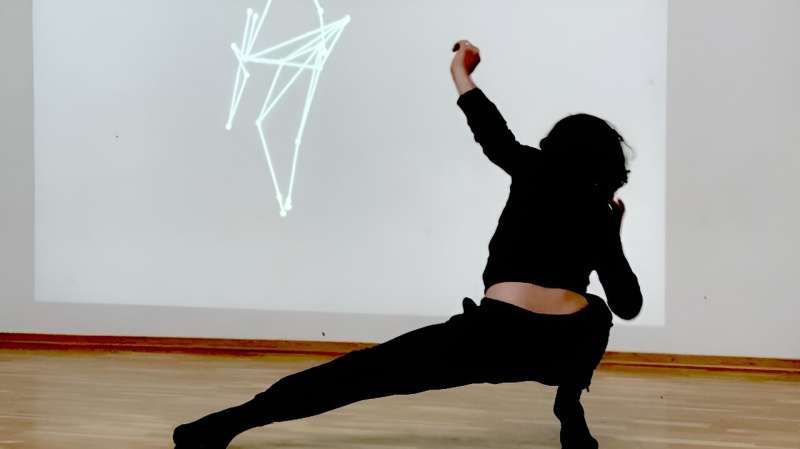This article has been reviewed according to Science X's editorial process and policies. Editors have highlighted the following attributes while ensuring the content's credibility:
fact-checked
trusted source
proofread
In art, AI can acquire an entirely new purpose

Researcher Benedikte Wallace set out to teach a computer how to dance. She ended up gaining new insight into how artificial intelligence (AI) can be used in creative practice.
Artificial intelligence is essentially trained to be correct. Humans feed it with dozens of examples from real life in order to make the AI respond or act as a superhuman.
Benedikte Wallace wanted to explore the use of AI in dance. In her Ph.D., she spent more than a year collecting human dance examples and feeding them into the computer. Around 30 dancers stepped by the recording room and improvised to music before the AI received hundreds of snapshots from their performances.
In this way, the AI should learn to dance—as lines on a screen.
"About halfway through the degree, I finally had something that looked like human dance. However, then I found that the examples the dancers preferred, were the ones where the AI made mistakes," Wallace says.
She recently completed her Ph.D. at the RITMO Centre for Interdisciplinary Studies in Rhythm, Time and Motion, University of Oslo.
A long arm and impossible angles
All of a sudden, she had a discovery that could reveal more about the usefulness of AI in creative professions.
"The dancers didn't necessarily want a perfect copy of a human dancer. They wanted to be surprised: to see something that isn't human," Wallace says.
The movements that created excitement were often the strange ones—an arm that stretched to a length of three meters or curled into a small ball. Arms and legs bending in impossible angles were also popular.
"The dancers started asking themselves how they could transfer such movements to their own bodies."
Igniting creativity
The phenomenon is not entirely new. There are several examples of the use of such absurd prompts to initiate creative processes.
In 1975, musician Brian Eno and multimedia artist Peter Schmidt published their Oblique Strategies: a deck of cards where each card offered a so-called aphorism, for instance a sentence or a quote that should help artists break creative blocks.
"In research on inspiration and creativity, we often see this come up. If you are surprised or challenged, this can have a positive effect on inspiration, motivation and problem solving."
Using AI in this way is still out of the ordinary, according to Wallace.
"If an AI forecasts the weather for tomorrow, you do not want it to tell you something impossible. However, my results indicate that we have to think differently if we are to use AI in creative practices. Perhaps we need to explore the unreal, that is, behavior that can only come from something not human."
Need for a close collaboration
In the further exploration of AI and creative professions, Wallace believes it may be wise to rethink methodologies.
"In any case, we must work closely with the intended users," she says.
In her own project, the dancers started trying out the AI after she had fed all data into it. She had been working hard to make the machine's dance look realistic.
"If I had started in the opposite end, by talking to the dancers about what they wanted, the project probably would have taken a different direction."
A new dance
In the future, Wallace believes that creative professions will use AI in various ways.
"Today there are still technical obstacles. When it comes to dance, the machine cannot generate this immediately—it requires a lot of data processing. If you are on stage, ten seconds is a very long wait," she says.
However, processing speed will increase. Eventually, it may become possible for dancers to use an app on their cell phone.
"At that point, I believe we will get to see some pretty cool collaborations between AI and humans."
We might see other types of performances, for instance dancers' movements being fed into the AI in real time while the AI immediately responds, she suggests.
"However, coming from the research side, I will always be a little behind. When these things are super accessible and easy to use—for anyone—unpredictable things will happen. It is not until then that we will know which role AI ends up getting in the world of art."


















